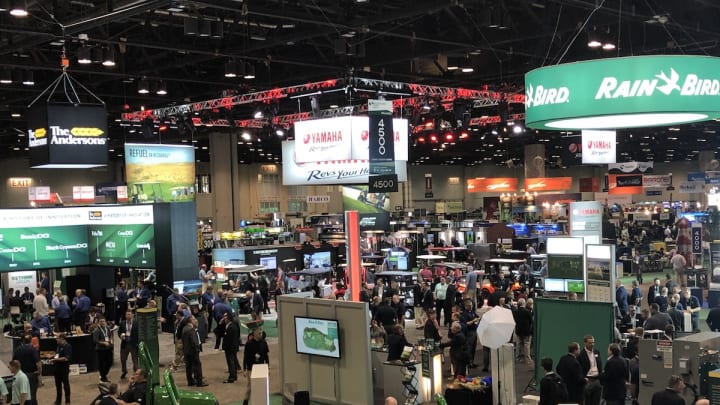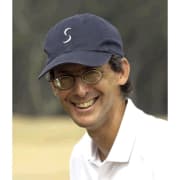A game changer, from the ground up

ORLANDO, Fla. – What happens when you put 4,100 golf course superintendents in a big room filled with tractors, fertilizer, seed and irrigation systems?
Does anybody really care?
Everyday golfers should, because when you have the collective wisdom of an entire industry at a trade show such as the recently concluded Golf Industry Show here, everyone associated with the game can benefit.

This isn’t just some social gathering for golf course tradesmen. These are professionals: greenkeepers (Golf Course Superintendents Association of America), architects (American Society of Golf Course Architects), builders (Golf Course Builders Association of America) and facility owners (National Golf Course Owners Association of America).
Many attendees find time for golf, but most of them show up to attend workshops, get certified, kick tires, learn trade secrets and find out the last developments that will help them do their jobs better and keep the game sustainable. Unless golf can be a viable business, it won’t serve its primary purpose, which is to be a game enjoyed by millions – 21 million here in the U.S., and at least as many more worldwide.
There are four important developments evident on the show floor and heard discussed in the hallways at the Orange County Convention Center that will be reshaping the game for the next few decades:
Labor availability and costs: Simply put, golf courses are having a tougher time than ever finding labor, and the workers whom the industry get are costing more – a lot more now that the minimum wage will rise in 21 states in 2020, including such golf-intense places as Arizona, California, Florida, Illinois, Michigan, New York and Ohio.
Between full employment nationally and increasing restrictions on immigrant labor, clubs across the country are scrambling for help. Not just for laborers, but also for skilled employees such as assistant superintendents and irrigation technicians, because enrollments in turf schools have taken a nosedive in the past decade. Labor already eats up 55-70 percent of a maintenance budget. If labor costs go up, as expected, by an average of $100,000 in the next three years, that’s an additional $3-$4 per round that will be passed on to consumers.
Robotics: The busiest display on the GIS floor was the robotic, GPS-guided motorized equipment at the Toro booth. Toro wasn’t the only vendor selling such wares, just the biggest as seen with its army of salesmen and throng of interested greenkeepers. The hardware is now on the market: greens mowers, fairway and rough units, sprayers. topdressers, even an autonomous range picker.
The skepticism has faded, and the issue now is price and whether it’s worth it. For a growing number of superintendents, the answer is “yes.” The upper-scale clubs will be buying in. That means more preparation at night, better course conditions in the morning, and a greater gulf between the premier clubs and everyone else in the industry – which is about the 75 percent of the trade that represents second-tier private clubs, mom-and-pop-run smaller facilities, municipal courses that would face resistance from unions, and a large group of courses (public and private) struggling to meet basic budget concerns without the available capital-expenditure funds required to compete these days.
Resource sustainability: Forget about any uniformly green, lush standard for maintenance. From now on, inventiveness goes. Painting dormant Bermudagrass fairways or putting surfaces green rather than overseeding them saves considerably on water, labor and chemical inputs. Letting roughs go native rather than maintaining them as cultivated turfgrass also saves a lot. Abandoning out-of-play areas identified as such by sophisticated measurement and tracking technologies renders conditioning more effective. Drought-tolerant grasses are increasingly in vogue in regions where potable community water is becoming scarcer, more expensive and politically less expedient.
There’s going to be more emphasis on providing wildlife habitat, especially bee corridors. The result is going to be more diversity in the look and feel of golf courses and more of an integration with native habitats and less of an artificially manicured look. Get used to it.
Mindfulness: Sustainability in golf extends to superintendents themselves. That’s what animated a four-hour session devoted to “Mindfulness” attended by 120 greenkeepers – in what was demographically the most culturally diverse audience of the entire show. Historically, greenkeepers are drawn from a narrow cast, but efforts to diversify have been fruitful in terms of race, gender and country of origin. Not surprisingly, the new generation of greenkeepers brings a new state of mind to their jobs, one which rejects the levels of stress, overwork and 80-hour work weeks traditionally associated with the trade.
The workshop was led by two accomplished superintendents: Chris Tritabaugh of Hazeltine National Golf Club in Chaska, Minn., and Paul MacCormack of Fox Meadow Golf Club in Stratford, Prince Edward Island, where he also is the general manager. They emphasize improving the work/life balance of their colleagues. Being mindful of the need to de-stress, delegate, empower colleagues and enjoy one’s family does not entail a lowering of maintenance standards. Tritabaugh got his course primed for the 2016 Ryder Cup. MacCormack, who is very big on meditation, reminded his audience that a state of mental inwardness is not the proper cure for fixing a break in an 8-inch main line – though it probably is a good way to recover from the ordeal afterwards.
The point here and throughout the 2020 superintendents show is that there is a whole new world out there for getting a golf course – and a staff – ready for the long haul.
To receive Morning Read’s newsletters, subscribe for free here.
